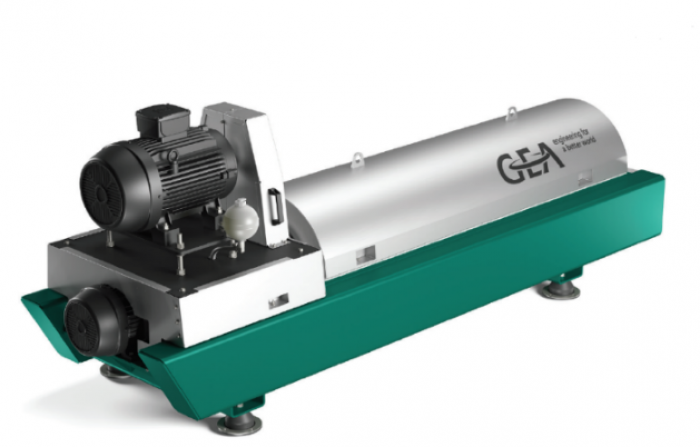The decanter’s hour has come as soon as the solids content in the suspension to be processed is particularly high. These machines provide the benefits of high clarifying efficiency and maximum dewatering as well as the separation of liquids with the simultaneous removal of solids. The main requirements in this respect include a high bowl speed, a powerful drive for the scroll and a scroll speed which automatically adapts to the solids loading in the feed. Due to its versatility and the technological know-how of GEA, the decanter can be used for a wide range of process tasks; from clarification through separation, classification, concentration and washing right up to extraction.
Clarifying decanters are used to separate solids out of a suspension to obtain a virtually solids-free, clarified liquid. Dewatering decanters ensure maximum concentration of the solids to get them as dry as possible. Separating decanters separate two chemically immiscible liquids with simultaneous separation of the solids. Classifying decanters split the solids mixture of the suspension into a fine (small particles) and a coarse (large particles) fraction. Extraction decanters mix a liquid containing a solid or extract with a liquid agent which contains the solids or liquid after mixing. Finally, there is the possibility of integrating a co-current, counter-current or dilution washing system in the decanter for washing the suspended solids.
2-Phase Separating Decanter
The 2-Phase Separating Decanter is a centrifuge in which the clarified and separated oil phase is gravity discharged on the decanter's liquid side while the heavy liquid phase leaves the decanter together with the solids.
3-Phase Separating Decanter
The 3-Phase Separating Decanter is a centrifuge in which two liquids of different densities are separated from each other. At the same time solids are separated and discharged.
The feedstock enters the decanter through feed tube and flows into the centrifugation space through the distributor. The conveyor screw transports the solids to the solids discharge. The level of the liquid can be adjusted by fitting regulating rings or disks of the required inner diameter. Separation of the two liquid phases takes place in the separation zone, whereby the light phase flows towards the bowl axis, and the heavy phase towards the bowl wall.
Regarding the discharge of the liquid phases 3-Phase Separating Decanters are available in numerous designs. Liquid phases can be discharged by gravity or under pressure by centripetal pump.
In the case of a 3-Phase Separating Decanter with centripetal pump for the light phase and gravity discharge of the heavy phase, the light liquid phase leaves the centrifugation space over an exchangeable regulating ring and is discharged under pressure by the centripetal pump. At the same time, the heavy liquid phase is discharged under gravity through exchangeable regulating tubes.
Another technical variant is the case of a 3-Phase Separating Decanter with centripetal pump for the heavy phase and gravity discharge of the light phase. The choice of the appropriate design depends on the product to be separated and the lay-out of the customer installation.
